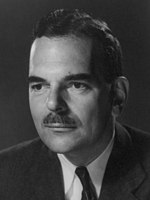| ||||||||||||||||||||||||||
All 14 North Carolina votes to the Electoral College | ||||||||||||||||||||||||||
|---|---|---|---|---|---|---|---|---|---|---|---|---|---|---|---|---|---|---|---|---|---|---|---|---|---|---|
| ||||||||||||||||||||||||||
 County Results
| ||||||||||||||||||||||||||
| ||||||||||||||||||||||||||
| Elections in North Carolina |
|---|
 |
The 1944 United States presidential election in North Carolina took place on November 7, 1944, as part of the 1944 United States presidential election. North Carolina voters chose 14[2] representatives, or electors, to the Electoral College, who voted for president and vice president.
As a former Confederate state, North Carolina had a history of Jim Crow laws, disfranchisement of its African-American population and dominance of the Democratic Party in state politics. However, unlike the Deep South, the Republican Party had sufficient historic Unionist white support from the mountains and northwestern Piedmont to gain one-third of the statewide vote total in most general elections,[3] where turnout was higher than elsewhere in the former Confederacy due substantially to the state’s early abolition of the poll tax in 1920.[4] Like Virginia, Tennessee and Oklahoma, the relative strength of Republican opposition meant that North Carolina did not have statewide white primaries, although certain counties did use the white primary.[5] A rapid move following disenfranchisement to a completely “lily-white” state GOP also helped maintain Republican support.[6]
In 1928, anti-Catholicism in the Outer Banks and growing middle-class urban Republicanism in Piedmont cities turned North Carolina to GOP nominee Herbert Hoover,[7] but this was sharply and severely reversed with the coming of the Great Depression. With the South having the highest unemployment in the nation and blaming its fate upon the North and Wall Street,[8] exceptionally heavy support was given to Democratic nominee Franklin D. Roosevelt in 1932 and 1936 everywhere except in a few rock-ribbed Republican mountain bastions.[7] Nevertheless, there was virtually no change to the state’s social structure during the New Deal,[9] and the conservative “Shelby Dynasty” was strong enough to prevent any populist challenge so much as developing.[10] Additionally, the state was among the least isolationist and strongly supported aid to Britain during the early phase of World War II,[11] while the absence of a statewide white primary meant local response to the landmark court case of Smith v. Allwright was generally calm.[5] However, the precarious health of incumbent President Franklin D. Roosevelt produced strong Southern opposition to vice-President Henry A. Wallace, who was viewed as a dangerous liberal throughout the region.[12] Initially the South attempted to have former Supreme Court Justice James F. Byrnes replace Wallace, but Byrnes was unacceptable because of his lapsed Catholicism to the northern Catholic urban bosses, and also to the party’s union backers.[13] Consequently, Missouri Senator Harry S. Truman became Roosevelt’s running mate.[14]
Polls were not taken in the state, but less than a week before the poll there were appeals to state Democrats to not support FDR for a fourth term.[15]
- ^ "United States Presidential election of 1944 – Encyclopædia Britannica". Retrieved July 19, 2018.
- ^ "1944 Election for the Fortieth Term (1945-49)". Retrieved July 19, 2018.
- ^ Phillips, Kevin P. (November 23, 2014). The Emerging Republican Majority. Princeton University Press. pp. 210, 242. ISBN 978-0-691-16324-6.
- ^ Key, Valdimer Orlando (1949). Southern Politics in State and Nation. Alfred A. Knopf. p. 502.
- ^ a b Klarman, Michael J. (2001). "The White Primary Rulings: A Case Study in the Consequences of Supreme Court Decision-Making". Florida State University Law Review. 29: 55–107.
- ^ Heersink, Boris; Jenkins, Jeffery A. (2020). Republican Party Politics and the American South, 1865–1968. Cambridge University Press. pp. 48–50, 239–243. ISBN 9781316663950.
- ^ a b Phillips. The Emerging Republican Majority, pp. 212-215
- ^ Ritchie, Donald A. (2007). Electing FDR: the New Deal campaign of 1932. Lawrence, Kansas: University Press of Kansas. p. 143. ISBN 978-0700616879.
- ^ See Abrams, Douglas Carl (1992). Conservative constraints: North Carolina and the New Deal. Jackson, Mississippi: University Press of Mississippi. ISBN 9780878055593.
- ^ Christensen, Rob (2010). The paradox of Tar Heel politics: the personalities, elections, and events that shaped modern North Carolina. Chapel Hill, North Carolina: University of North Carolina Press. pp. 62–68. ISBN 9780807899632.
- ^ See Menendez, Albert J. (2005). The Geography of Presidential Elections in the United States, 1868-2004. McFarland. p. 68. ISBN 0786422173.
- ^ Weintraub, Stanley (2012). "Bungled Beginnings". Final victory: FDR's Extraordinary World War II Presidential Campaign. Philadelphia: Da Capo Press. pp. 23–28. ISBN 9780306821134.
- ^ Divine, Robert A. (1974). Foreign policy and U.S. presidential elections, 1940-1948. New York, New York: New Viewpoints. pp. 119–120. ISBN 0531064956.
- ^ Weintraub, Stanley (2012). "The Missouri Compromise". Final victory: FDR's Extraordinary World War II Presidential Campaign. pp. 37–48.
- ^ "Senator Wherry Heard At Rally — GOP Senate Whip Urges "Jeffersonian Democrats" To Vote Against FDR". The News and Observer. Raleigh, North Carolina. November 2, 1944. p. 2.

